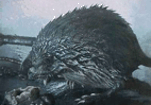Natural History:
The Russian desman (or "vyhuhol") is widespread in the major river
basins of European Russia and easternmost Ukraine, but is rare due to
extensive trapping in the 19th century, displacement by introduced
muskrats, and habitat loss.
Similar to muskrats in size and appearance, Desmana possesses a
glossy waterproof pelt and a long tail flattened from side to side.
However, they are easily distinguished by their long, constantly moving
snout. These aquatic invertebrate eaters are active year-round, though
mostly at dusk. Signs of their presence are piles of empty snail shells,
and deep trails in the bottom silt fanning out from their burrow entrance.
Burrows are typically 1-10 m long, with a underwater entrance 12-14 cm
high and 15-18 cm wide. Another type of burrow is built in large tussocks,
with the tunnel rising as a spiral from the entrance to the nest. The
nesting chamber is above water level, usually just below the soil surface
|
| |


Russian desman |
|
|





